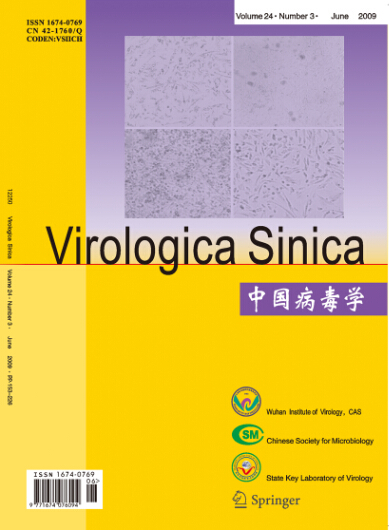Li-li XU, Zhi-hong HU, Hua-lin WANG, Xiao HAN, Fei DENG.Evaluation of Sensitivities and Specificities of SARS-CoV Detection by Real-time Quantitative Reverse Transcription-PCR Assays* .VIROLOGICA SINICA, 2009, 24(3): 187-193.doi: 10.1007/s12250-009-3021-8
Citation:
Li-li XU, Zhi-hong HU, Hua-lin WANG, Xiao HAN, Fei DENG.
Evaluation of Sensitivities and Specificities of SARS-CoV Detection by Real-time Quantitative Reverse Transcription-PCR Assays* .VIROLOGICA SINICA, 2009, 24(3)
: 187-193.
http://dx.doi.org/10.1007/s12250-009-3021-8
Evaluation of Sensitivities and Specificities of SARS-CoV Detection by Real-time Quantitative Reverse Transcription-PCR Assays*
-
State Key Laboratory of Virology, Wuhan Institute of Virology, Chinese Academy of Sciences, Wuhan 430071, China
-
Corresponding author:
Fei DENG, df@wh.iov.cn
-
Received Date:
30 December 2008
Accepted Date:
17 February 2009
Available online:
01 June 2009
Fund Project:
EPIS-ARS N°SP22-CT-2004-511603FP6 projects DISSECT N°SP22-CT-2004-511060The Knowledge Innovation Program of Chinese Academy of Sciences KSCX2-YW-N-065
-
Abstract
The etiological agent of severe acute respiratory syndrome (SARS) was identified as a new coronavirus, termed SARS-CoV. Establishment of an efficient and sensitive diagnostic system of SARS-CoV genetic materials is crucial for SARS control. In this study, we quantified SARS-CoV mRNAs in both infected cell culture lysate and in supernatant by using Real-time quantitative revere transcription-PCR based on EvaGreenTM dye and Taqman-MGB probes. For extensive evaluation of sensitivities and specificities, 13 pairs of primers and 4 probes were designed based on different genes of SARS-CoV. Glyceraldehydes-3-phosphate dehydrogenase (GAPDH) was selected as the internal control gene. Results showed that S-gene-specific PCR was the most sensitive for detection, but because of its sequence variability in the different viral strains, primers and a probe based on the N gene were suitable substitutions. Meanwhile, we found the mRNA concentrations in cell culture lysates were much higher than in cell supernatant and facilited more sensitive detection of the SARS-CoV.
-

-
-
References
-
Bressler A M, Nolte F S. 2004. Preclinical evaluation of two real-time, reverse transcription-PCR assays for detection of the severe acute respiratory syndrome coronavirus. J Clin Microbiol, 42: 987-991.
doi: 10.1128/JCM.42.3.987-991.2004
-
Drosten C, Chiu L L, Panning M M, et al. 2003. Identification of a novel coronavirus in patients with severe acute respiratory syndrome. N Engl J Med, 348: 1967-1976.
doi: 10.1056/NEJMoa030747
-
Drosten C, Gunther S, Preiser W, et al. 2004. Evaluation of advanced reverse transcription-PCR assays and an alternative PCR target region for detection of severe acute respiratory syndrome-associated coronavirus. J Clin Microbiol, 42: 2043-2047.
doi: 10.1128/JCM.42.5.2043-2047.2004
-
Emery S L, Erdman D D, Bowen M D, et al. 2004. Real-time reverse transcription -polymerase chain reaction assay for SARS-associated coronavirus. Emerg Infect Dis, 10: 311-316.
-
Gueudin M, Vabret A, Petitjean J, et al. 2003. Quantitation of respiratory syncytial virus RNA in nasal aspirates of children by real-time RT-PCR assay. J Virol Methods, 109: 39-45.
doi: 10.1016/S0166-0934(03)00042-9
-
Hui R K, Zeng F, Chan C M, et al. 2004. Reverse transcriptase PCR diagnostic assay for the coronavirus associated with severe acute respiratory syndrome. J Clin Microbiol, 42: 1994-1999.
doi: 10.1128/JCM.42.5.1994-1999.2004
-
Ksiazek T G, Erdman D, Goldsmith C S, et al. 2003. A novel coronavirus associated with severe acute respiratory syndrome. N Engl J Med, 348: 1953-1966.
doi: 10.1056/NEJMoa030781
-
Laurendeau I, Bahuau M, Vodovar N, et al. 1999. TaqMan PCR-based gene dosage assay for predictive testing in individuals from a cancer family with INK4 locus haploinsufficiency. Clin Chem, 45: 982-986.
-
Peiris J S, Chu C M, Cheng V C, et al. 2003. Clinical progression and viral load in a community outbreak of coronavirus-associated SARS pneumonia: a prospective study. Lancet, 361: 1767-1772.
doi: 10.1016/S0140-6736(03)13412-5
-
Peiris J S, Lai S T, Poon L L, et al. 2003. Coronavirus as a possible cause of severe acute respiratory syndrome. Lancet, 361: 1319-1325.
doi: 10.1016/S0140-6736(03)13077-2
-
Weidmann M, Zanotto P M, Weber F, et al. 2004. High-efficiency detection of severe acute respiratory syndrome virus genetic material. J Clin Microbiol, 42: 2771-2773.
doi: 10.1128/JCM.42.6.2771-2773.2004
-
Wong S C, Chan J K, Lee K C, et al. 2005. Development of a quantitative assay for SARS coronavirus and corre-lation of GAPDH mRNA with SARS coronavirus in clinical specimens. J Clin Pathol, 58: 276-280.
doi: 10.1136/jcp.2004.016592
-
Proportional views

-











